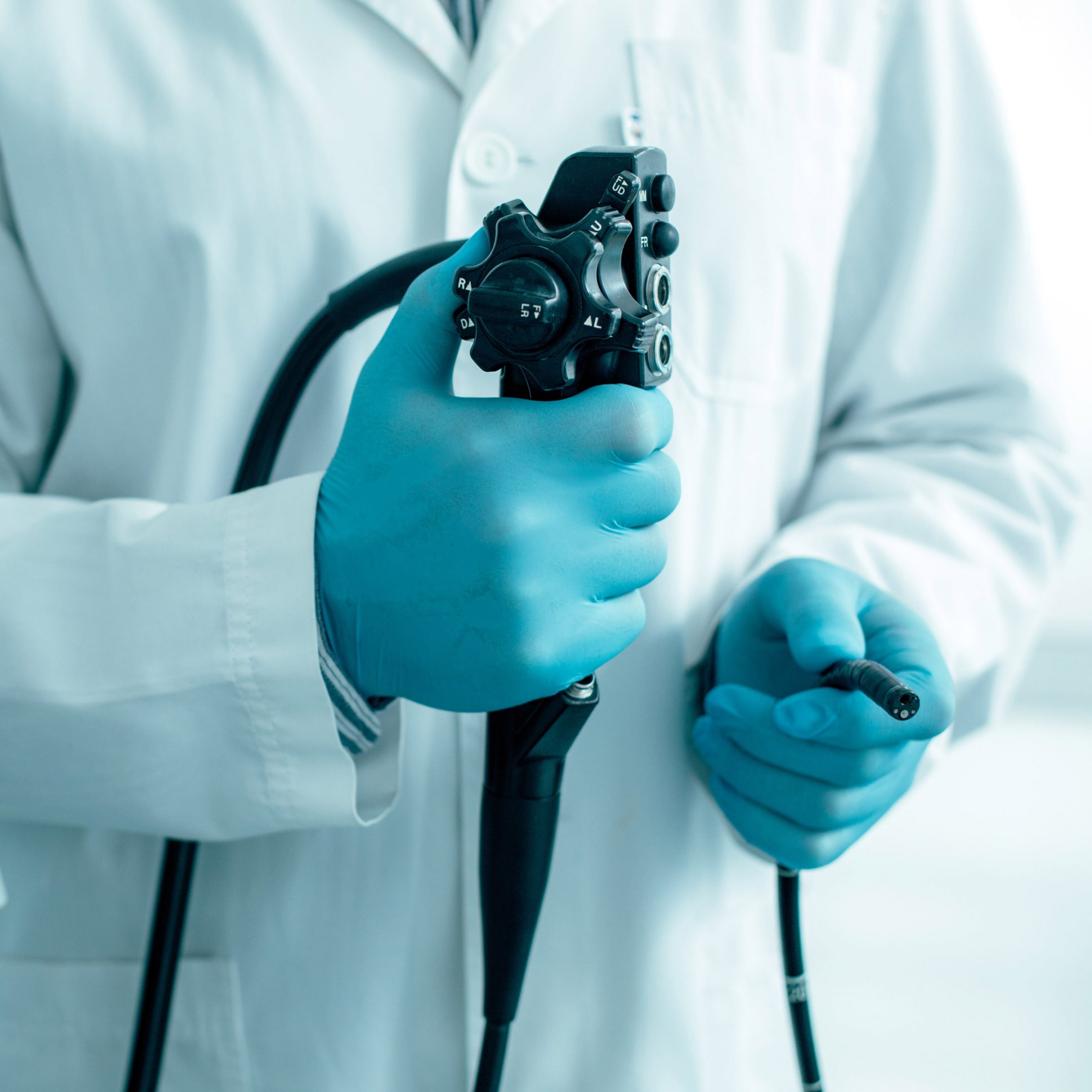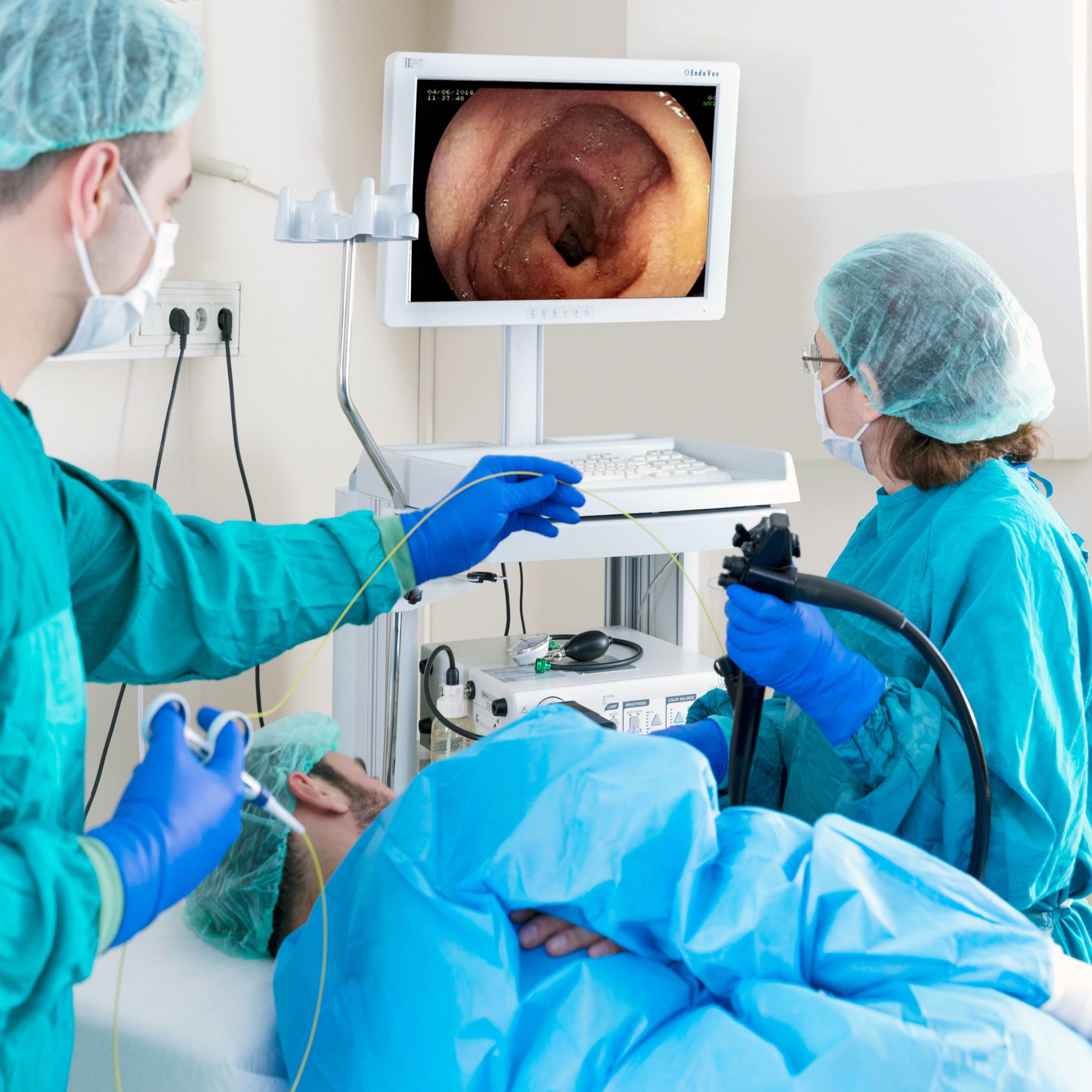
Upper GI Endoscopy
An upper GI endoscopy or EGD (esophagogastroduodenoscopy) is a non-surgical procedure used to examine and treat the upper part of your digestive tract. Without resorting to invasive surgery, it explores the esophagus, stomach, and first part of the small intestine (duodenum). An upper GI endoscopy can often identify disorders in their early stages before they become severe.
How is an EGD Done?
An EGD is done with an instrument called an endoscope. The endoscope is a long, thin tube outfitted with a camera and a bright light. It is inserted in the mouth and slowly passed through your upper GI, while the camera sends detailed video images to a monitor for analysis by your gastroenterologist.
Tools can also be passed through the tube. They can be used to:
- Remove objects that are lodged in the esophagus or stomach.
- Perform tissue biopsies and removing polyps.
- Dilate strictures (abnormal narrowing of a passage such as the esophagus).
- Stop bleeding.
- Perform endoscopic surgery.
- Perform laser surgery.
- Air pressure is also used to inflate the upper GI, so your doctor can see a larger area and see the lining in greater detail.

When is an Upper GI Endoscopy Necessary?
An EGD is often used to explore the hidden causes of inexplicable symptoms, including:
- Unexplained weight loss.
- Black or tarry stools.
- Anemia.
- Trouble swallowing.
- Upper GI tract bleeding.
- Blood in vomit.
- Persistent heartburn.
An upper endoscopy is better than X-rays in detecting abnormalities such as cancer and in its ability to scrutinize details of the upper GI more thoroughly.
What Conditions Can an Upper GI Identify?
An upper GI endoscopy can identify many conditions and in some cases, catch them before they get worse. These include:
- Ulcers.
- Celiac disease.
- Inflammation.
- Swelling.
- Blockages.
- Gastroeophageal reflux disease.
- Precancerous irregularities.
How Should I Prepare for an Upper GI Endoscopy?
Since the procedure concerns your digestive tract, you may not eat anything up to eight hours prior. Your stomach and duodenum (the first part of the small intestine immediately beyond the stomach) must be empty so that they can be viewed in as much detail as possible. Your doctor may permit you to take sips of water. Do not take any medications or herbs that can cause bleeding, including:
- Antacids.
- Aspirin (Bayer, Excedrin).
- Ibuprofen (Motrin, Advil).
- Green tea.
- Vitamin E.
- Garlic.
- Anti-clotting medications.
- Estrogen creams or patches.
- Diabetes medications.
- Antidepressants.
- Chewing gum and smoking are also off-limits.
Your physician will give you a detailed list to follow and may also put you on a special diet a day or two before the procedure.
What Can I Expect Before an Upper GI Endoscopy?
An upper GI endoscopy is an outpatient procedure. You will be asked to remove jewelry, dentures, and any body jewelry you may have on your lips or in your tongue. If you need to remove your clothing, you’ll be provided with a hospital gown.
Your doctor will spray your throat with a numbing agent, or have you gargle a liquid anesthetic so you don’t feel the endoscope. You’ll also receive some type of sedation to help you relax and feel less nervous during the procedure. Sedation is also helpful if you’re concerned about gagging during the endoscopy. There are four levels of sedation, and the one administered to you will depend on the intensity of your anxiety:
- Minimal Sedation – If you receive minimal sedation, you’ll be in a drug-induced state in which you’re awake but relaxed.
- Moderate or Conscious Sedation – With moderate sedation, you’ll be given a combination sedative/painkiller. You’ll be responsive but may be groggy and fade in and out of consciousness. The sedation will be administered via an IV or injection. Afterward, you may not recall what happened.
- Deep Sedation – If you’re deeply sedated, you’re on the brink of consciousness, and it takes vigorous effort for someone to awaken you.
- General Anesthesia – Under general anesthesia, you are totally unconscious.

What Happens During an Upper GI Endoscopy?
During an upper GI endoscopy, a plastic mouth guard is placed in your mouth to keep it open, protect your teeth from the endoscope and prevent you from accidentally biting it.
Monitors are connected to your body that keep track of your breathing, heartbeat, and blood pressure.
You will be placed on your side, and your doctor will slowly guide the endoscope into your mouth and through your digestive tract. The camera on the end of the endoscope will send images to a monitor that your doctor will observe throughout the procedure to detect any abnormalities.
The endoscope will release air into your stomach, inflating it so the lining can be more easily seen. If necessary, the doctor will pass surgical instruments through the tube to detach polyps or take biopsies.
Your doctor may also do a cytology test during the procedure, using a very small brush to gather cell samples.
The whole procedure takes approximately 30 minutes.
What Happens After an Upper GI Endoscopy?
After the EGD, you’ll be closely monitored as the sedative wears off to ensure that there are no complications. You may feel bloated from the air that was in your stomach and be gassy. Also, your throat may be sore. Gargling with warm salt water can provide relief. Your doctor will tell you when you can eat again and when you can resume taking any medications you discontinued for the procedure.
Be sure to make arrangements in advance for a responsible adult to drive you home. You cannot drive when you are under the influence of a sedative, even if it’s wearing off. It would also be helpful if the person who drove you home can stay with you for about two hours.
What are the Potential Complications of an Upper GI Endoscopy?
As with any medical procedure, an EGD can have complications. If you have any of the following symptoms afterward, get medical care immediately.
- Severe sore throat that gets worse.
- Shortness of breath.
- Difficulty swallowing.
- Fever of 100.4 degrees Fahrenheit or more.
- Shaking chills.
- Tarry or bloody bowel movements.
- Chest pain.
- Intense stomach pain that doesn’t resolve when you pass gas.
- Bloody vomit.
If you are suffering because of upper digestive pain and discomfort, the seasoned professionals at Gastro MD are here to provide relief. Our doctors are committed to offering the utmost in upper GI endoscopy treatments to help you feel as good as possible, as soon as possible.
Contact Us
Contact us today! The team of professionals at Gastro MD looks forward to working with you. We are one of the leading gastroenterology practices in the Tampa Bay area. We perform a host of diagnostic procedures using state-of-the-art equipment in a friendly, comfortable, and inviting atmosphere where patient care is always a top priority!



